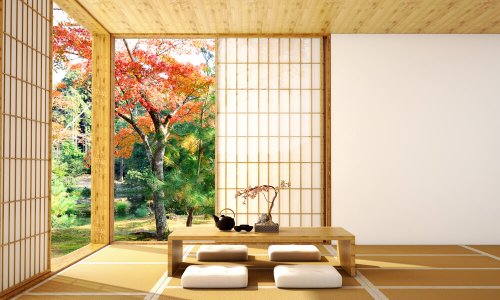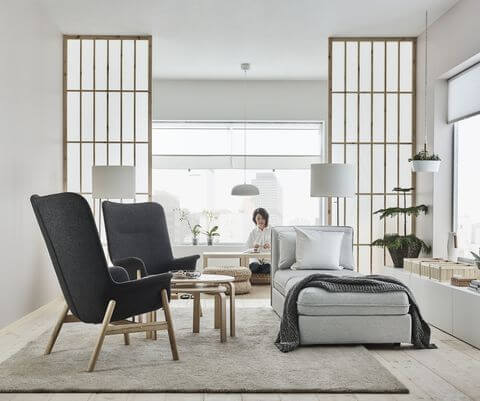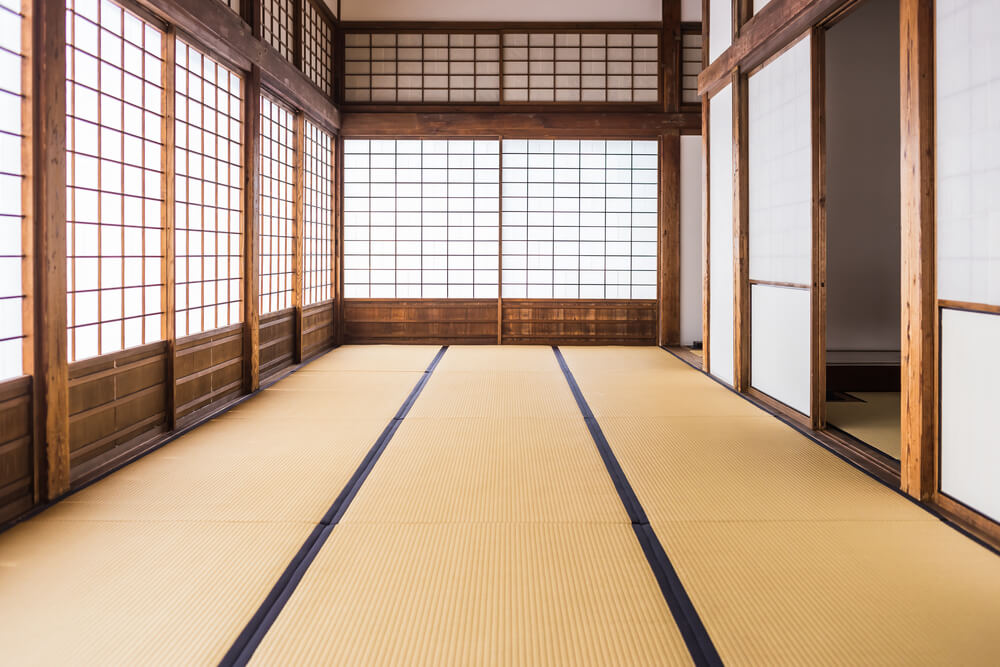Interior Decor Trends: Japanese Decoration

Oriental art has always been a source of inspiration for designers around the world. In fact, Asian cultures have had a huge influence on Western style over the years. In this article, we want to tell you all about Japanese decoration, a style that reflects the Buddhist concept of zen and the search for perfect harmony.
Appreciation for natural beauty lies at the heart of Japanese decor, and the simple designs are the perfect way to maintain balance between order and cleanliness. In this article, we’ll tell you everything you need to know about using Japanese decor in your home.
Japanese decoration: how to use your space

In Japanese decor, how you use your space is essential. In a country where city apartments are so small, it’s important to make the most of every inch of space.
The Japanese design and create furniture that helps create open spaces, and a peaceful environment. But how exactly do they do this?
- The furniture arrangement is crucial. The designs are inspired by the principles of Feng Shui, a pseudo-science that aims to create a sense of balance between people and their surroundings.
- Modular rooms: this helps save space in small apartments, and makes it easier to create a sense of order.
- The center of the room should be clear and uncluttered. Designers achieve this by using low furniture, which helps to create a brighter and more spacious home.
- Order is the key to great Japanese decoration, and good storage is essential for creating a tidy, spacious home. Placing shelves high up on the walls also helps to create more living space.
- Shoji or sliding screens: these partition walls are made up of light, translucent paper over a lattice of wood or bamboo. The thin paper lets in much more light, helping to create a brighter space.
Dan sha ri – Japanese minimalism

Two of the central ideas behind Japanese decor are order, and avoiding unnecessary items. One of the greatest ambassadors of this philosophy is Marie Kondo, whose famous reality tv show teaches people how to get rid of all their useless possessions.
One of the most notable features of this style is the simplicity of the shapes. The Japanese constantly seek to create harmony between the different elements in their homes. They believe that the best way to achieve this balance is to use pure, minimalist shapes.
I saw the native home in Japan as a supreme study in elimination – not only of dirt, but the elimination of the insignificant.
As you can see, Japanese interior decor is a very practical form of art, in that it’s main aim is functionality. In keeping with this principle, the furniture used in Japanese decor stands out for the purity of its shapes, and its clean, simple sense of order.
Japanese decoration: furniture

Because of the Japanese philosophy around order and functionality, the main focus of the interior decor is on the furniture. These are some of the pieces of furniture most commonly found in Japanese homes:
- Tatamis: As we’ve already mentioned, Japanese decoration mainly uses low furniture. One of the most typical pieces of furniture you’ll find are tatamis. Tatamis are a type of straw mat, that were originally used as seating by ancient Japanese nobles.
- Futons: another way to make the most of the space is to place a futon on top of a tatami. These traditional seats are really versatile. You can pick them up and move them easily, allowing you to transform a bedroom into a living room in next to no time.
- Kotatsu: the kotatsu is the equivalent of the nightstand. These low tables have a small built-in heater to keep you warm in winter.
- Tansu: finally, we couldn’t finish this article without mentioning tansu. These small, wooden storage cabinets closely resemble old-fashioned chests. They are made up of a series of drawers which are concealed behind lacquered doors. Although people originally used them like suitcases, they have since become a staple of Japanese decoration.
Oriental art has always been a source of inspiration for designers around the world. In fact, Asian cultures have had a huge influence on Western style over the years. In this article, we want to tell you all about Japanese decoration, a style that reflects the Buddhist concept of zen and the search for perfect harmony.
Appreciation for natural beauty lies at the heart of Japanese decor, and the simple designs are the perfect way to maintain balance between order and cleanliness. In this article, we’ll tell you everything you need to know about using Japanese decor in your home.
Japanese decoration: how to use your space

In Japanese decor, how you use your space is essential. In a country where city apartments are so small, it’s important to make the most of every inch of space.
The Japanese design and create furniture that helps create open spaces, and a peaceful environment. But how exactly do they do this?
- The furniture arrangement is crucial. The designs are inspired by the principles of Feng Shui, a pseudo-science that aims to create a sense of balance between people and their surroundings.
- Modular rooms: this helps save space in small apartments, and makes it easier to create a sense of order.
- The center of the room should be clear and uncluttered. Designers achieve this by using low furniture, which helps to create a brighter and more spacious home.
- Order is the key to great Japanese decoration, and good storage is essential for creating a tidy, spacious home. Placing shelves high up on the walls also helps to create more living space.
- Shoji or sliding screens: these partition walls are made up of light, translucent paper over a lattice of wood or bamboo. The thin paper lets in much more light, helping to create a brighter space.
Dan sha ri – Japanese minimalism

Two of the central ideas behind Japanese decor are order, and avoiding unnecessary items. One of the greatest ambassadors of this philosophy is Marie Kondo, whose famous reality tv show teaches people how to get rid of all their useless possessions.
One of the most notable features of this style is the simplicity of the shapes. The Japanese constantly seek to create harmony between the different elements in their homes. They believe that the best way to achieve this balance is to use pure, minimalist shapes.
I saw the native home in Japan as a supreme study in elimination – not only of dirt, but the elimination of the insignificant.
As you can see, Japanese interior decor is a very practical form of art, in that it’s main aim is functionality. In keeping with this principle, the furniture used in Japanese decor stands out for the purity of its shapes, and its clean, simple sense of order.
Japanese decoration: furniture

Because of the Japanese philosophy around order and functionality, the main focus of the interior decor is on the furniture. These are some of the pieces of furniture most commonly found in Japanese homes:
- Tatamis: As we’ve already mentioned, Japanese decoration mainly uses low furniture. One of the most typical pieces of furniture you’ll find are tatamis. Tatamis are a type of straw mat, that were originally used as seating by ancient Japanese nobles.
- Futons: another way to make the most of the space is to place a futon on top of a tatami. These traditional seats are really versatile. You can pick them up and move them easily, allowing you to transform a bedroom into a living room in next to no time.
- Kotatsu: the kotatsu is the equivalent of the nightstand. These low tables have a small built-in heater to keep you warm in winter.
- Tansu: finally, we couldn’t finish this article without mentioning tansu. These small, wooden storage cabinets closely resemble old-fashioned chests. They are made up of a series of drawers which are concealed behind lacquered doors. Although people originally used them like suitcases, they have since become a staple of Japanese decoration.







